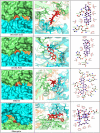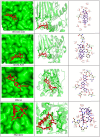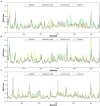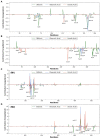Targeting envelope proteins of poxviruses to repurpose phytochemicals against monkeypox: An in silico investigation
- PMID: 36687601
- PMCID: PMC9849581
- DOI: 10.3389/fmicb.2022.1073419
Targeting envelope proteins of poxviruses to repurpose phytochemicals against monkeypox: An in silico investigation
Abstract
The monkeypox virus (MPXV) has become a major threat due to the increasing global caseload and the ongoing multi-country outbreak in non-endemic territories. Due to limited research in this avenue and the lack of intervention strategies, the present study was aimed to virtually screen bioactive phytochemicals against envelope proteins of MPXV via rigorous computational approaches. Molecular docking, molecular dynamic (MD) simulations, and MM/PBSA analysis were used to investigate the binding affinity of 12 phytochemicals against three envelope proteins of MPXV, viz., D13, A26, and H3. Silibinin, oleanolic acid, and ursolic acid were computationally identified as potential phytochemicals that showed strong binding affinity toward all the tested structural proteins of MPXV through molecular docking. The stability of the docked complexes was also confirmed by MD simulations and MM/PBSA calculations. Results from the iMODS server also complemented the findings from molecular docking and MD simulations. ADME analysis also computationally confirmed the drug-like properties of the phytochemicals, thereby asserting their suitability for consumption. Hence, this study envisions the candidature of bioactive phytochemicals as promising inhibitors against the envelope proteins of the MPXV, serving as template molecules that could further be experimentally evaluated for their efficacy against monkeypox.
Keywords: bioactive phytochemicals; drug repurposing; envelope proteins; molecular docking; molecular simulation; monkeypox virus; poxviruses.
Copyright © 2023 Gulati, Chadha, Harjai and Singh.
Conflict of interest statement
The authors declare that the research was conducted in the absence of any commercial or financial relationships that could be construed as a potential conflict of interest.
Figures











References
-
- Balkrishna A., Pokhrel S., Singh H., Joshi M., Mulay V. P., Haldar S., et al. (2021). Withanone from Withania somnifera attenuates SARS-CoV-2 RBD and host ACE2 interactions to rescue spike protein induced pathologies in humanized zebrafish model. Drug Des. Devel. Ther. 15, 1111–1133. doi: 10.2147/DDDT.S292805, PMID: - DOI - PMC - PubMed
LinkOut - more resources
Full Text Sources

